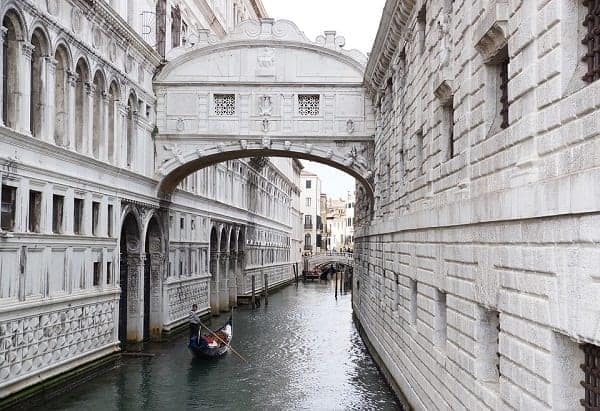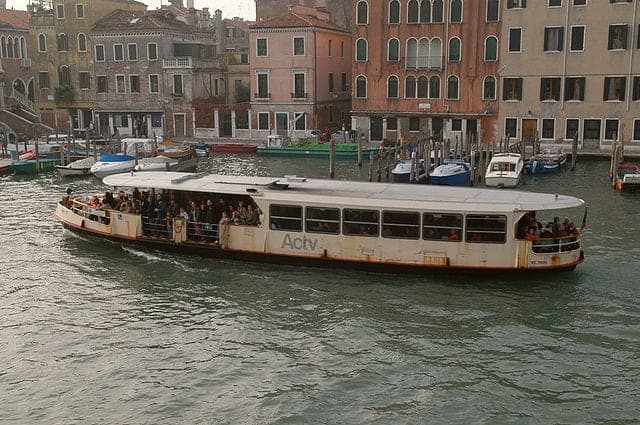In this post, we list the 12 must-see thing in St. Mark's Square in Venice.
We also include directions on how to get here, a map to help you explore on your own, as well as recommendations for guided tours.
St. Mark's Square Map
Click the map to enlarge or download it to your phone.
1. St. Mark’s Square
This public square is lined with several historic buildings, cafes, shops, and other notable sites.
At around 2 ½ acres, St. Mark’s Square is quite large and there are a lot of interesting things to see in the area.
St. Mark’s Basilica is located at the far end of the square, and you’ll find its 92 meter (300 ft.) tall bell tower to the right of the structure.
Between the basilica and the bell tower, you will see the Doge’s Palace in the distance.
The buildings surrounding the square are mostly former government offices that were in charge of Venetian trading outposts.
Napoleon once called St. Mark’s Square “the most beautiful drawing room in Europe,” and it’s not hard to see why.
This is a great place for people-watching during the day, but after dark, the lamplight really reveals how little has changed about this location throughout the centuries.
2. Caffe Florian
There are a few different cafes in the area of St. Mark’s Square, and each offers the same types of food at the same general price, often with local musicians performing classical music.
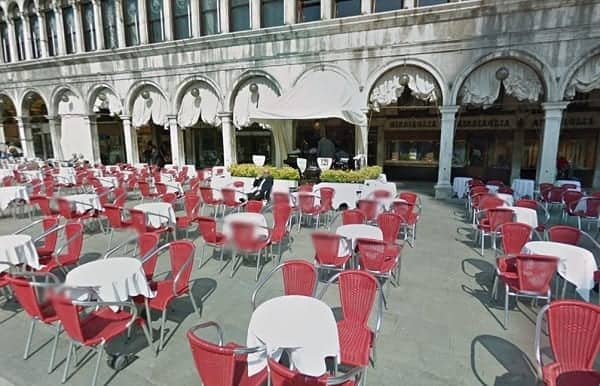
Caffe Florian, located on the Southern end of the square, has been around since 1720, and famous people such as Casanova and Charles Dickens have all dined here.
3. Caffe Quadri
Caffe Quadri is on the opposite side of the square, and they have also hosted several notable guests including Stendahl and Richard Wagner.
These are the two most notable cafes on the square, but there are others you can visit if you’re just looking for a quick bite or something to drink.
4. St. Mark’s Basilica
This is one of the oldest churches in all of Europe, dating back to 1063.
It is named after St. Mark, who wrote the story of Jesus in the bible.
Mark’s remains are said to be buried under the main altar in the basilica.
Despite its age, this is actually the most recent church founded in Venice.
The architecture on display here reflects the history of trade in Venice, with influences from Roman, Greek, Byzantine, French-Gothic, and even Muslim architectural styles.
Many consider this one of the most interesting churches in Europe.
And with all the different artistic approaches that were taken in its development over the years, it’s clear that this is one basilica that can’t be compared to any other.
You can enter this church and see the interior for yourself, and there’s even a free audio tour of St. Mark’s Basilica as well.
5. Torre dell'Orologio
You’ll find this structure to the left of St. Mark’s Basilica, and it dates back to about 1500.
If you look at the top of the tower, you’ll see two bronze Moors.
These were initially intended to be giants, but after the metal darkened over the centuries, they were given a different cultural background.
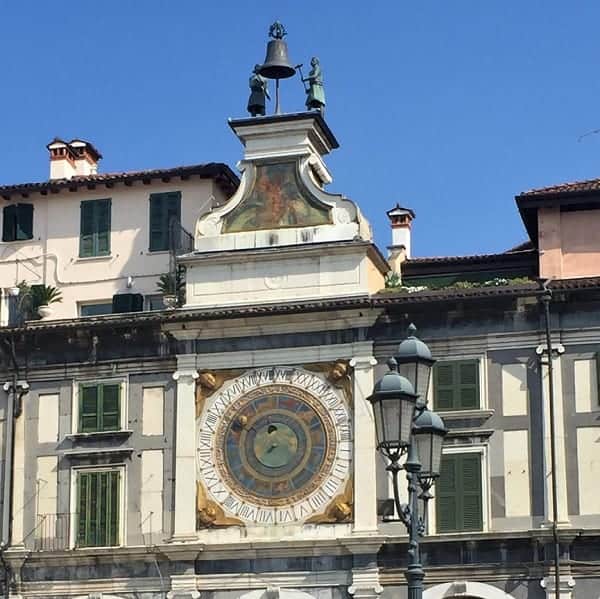
At the top of each hour, the moors swing their clappers. The dial of the clock shows all 24 hours, the zodiac, and even the phases of the moon at its center.
Look above the traditional dial to see the first digital clock in the world.
The clock tower also has a winged lion, the symbol of St. Mark, which holds an opened book reading “peace be with you, Mark.”
You can find this winged lion symbol all over the square if you look closely enough.
Shops & Crafts
With Venice’s history of trade, it should be no wonder there are several shops in the area where you can find a variety of items for purchase.
Some of the most popular items for sale in this city include glass products, masks, lace, and more.
You’ll find shops either up and down Mercerie street or under the arcade on the Northern side of the square.
6. Campanile/Bell Tower
Located near the center of the square and opposite the clock tower, the campanile was once actually the lighthouse which guarded the entrance to the Grand Canal.
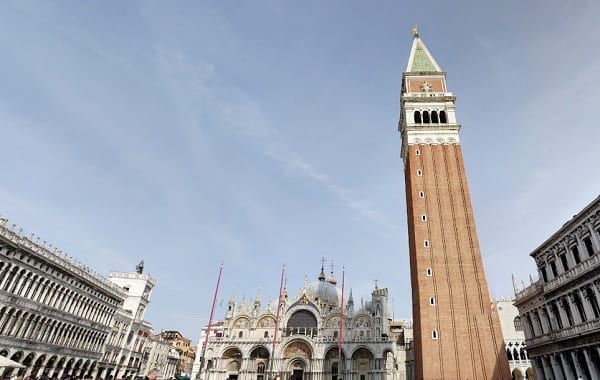
The bell tower you see today is not the original structure, as the first campanile fell in 1902.
That said, it was faithfully rebuilt 10 years later, and it’s a much stronger building today.
There is a lift which will take you to the top for excellent views of the city.
Floods at St. Mark’s Square
This square floods quite frequently, and when it does, you will hear warning sirens to let you know that the area is no longer safe.
Keep an eye out for puddles forming from the round white stones in the pavement.
During strong tides, the water flows like a river to the lowest areas of the square.
Although many doorways are designed to avoid flooding, it doesn’t always help.
This problem is expected to get worse as a result of rising sea levels.
7. Doge’s Palace
Located to the right of St. Mark’s Basilica, this pink Venetian Gothic building housed the government of the Venetian empire and has also served as the home of the Duke (or Doge).
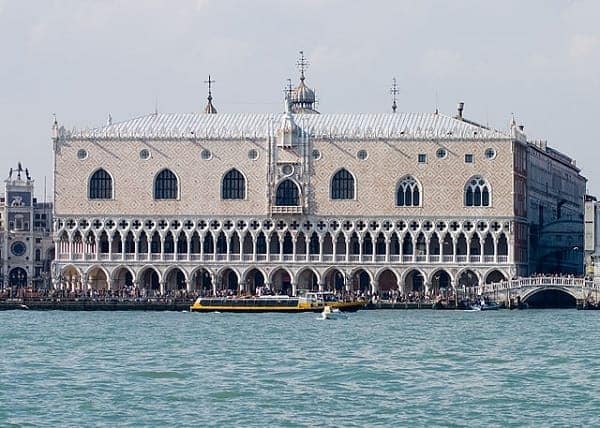
It is said that from 1150 - 1550, this was the most powerful location in Europe, despite its lacy and unprotected surroundings.
The palace was intentionally built this way to show that the Doge was an elected official and he had nothing to fear from his citizens.
Tickets are available to enter the palace, and its walls are lined with beautiful works of art from famous artists, so it’s definitely worth a visit.
8-9 Piazzetta
This is the small square between St. Mark’s Basilica and the San Marco Basin.
You’ll find the Doge’s Palace on one side of the Piazzetta and the Campanile on the other.
There are many small things to see in this area, including the Tetrarchs at the gate of the Doge’s Palace, the 7th Column of the palace, the San Marco Column, and the San Theodore Column.
Those last two columns were once taken from Constantinople and in the past they were used as execution sites for criminals.
10. Lagoon
You’ll find this stop just south of the Piazzetta.
It’s the site of a special celebration in which the Doge would board a boat and head out to the lagoon to perform a ritual in which he would toss a ring into the water.
The ring was a symbol of the marriage between Venice and its waters, an offering to reaffirm that connection.
The lagoon is 212 sq miles, and it’s home to many other islands.
Although it is big, it is also quite shallow, and you could technically walk across most of it.
12. Gondolas
As you stand and look out at the lagoon, chances are you’ll see a few of these boats in the area.
These gondolas are one of the most popular ways to get around the city.
These boats use just one oar, which is used both to thrust the boat forward and turn it one way or another.
They typically travel at about 3 miles per hour and take about as much energy as walking.
Today, there are only around 500 gondolas in Venice, and they are only available for tourists.
It can cost €100 or more to ride a gondola, so it’s probably a good thing you’re saving money on this tour!
We have a post explaining how to take a gondola ride.
13. Bridge of Sighs
Head to the bridge just beyond the Doge’s Palace to get a good look at this historic site by looking inland to the next bridge on the canal.
The Bridge of Sighs connects the palace with the prison.
It is said that after criminals were sentenced, they would be walked across the bridge, where they could take one last look at Venice before heading to jail.
The reality was likely far different than this romanticized version of events.
But, leave it to a poet like Lord Byron to give this bridge a wistful name despite its dark history.
And be sure to check out our other free walking tours of Venice.
This free self-guided walking tour will serve as a companion piece to a free audio tour of St. Mark’s Square (Piazza San Marco).
Whether you don’t have headphones to enjoy the audio version or you just prefer reading about the location, this is an excellent alternative.
How to Get to St. Mark’s Square
This public square is located on the southern end of Venice at the bottom of the Grand Canal. There are two main methods for getting here: on foot or by boat.
If you’re on the other end of the Grand Canal, the easiest way to get here is by hopping on a gondola or boat and enjoying a trip down the winding waterway.
Public Vaporetto
One of the most affordable options is the Vaporetto, a public waterbus that will take you down the entire length of the canal.
This option typically takes around 35 minutes to complete the journey.
It’s also worth noting that there is actually a free audio tour you can take which covers some of the more notable sites you’ll see on a boat ride down the Grand Canal.
The stop for St. Mark’s Square is at the end of Calle Vallaresso.
Walk up this road and turn right when you reach Piazza San Marco road, which will lead you directly to the square.
TIP: If you’re interested in this option, it’s worth noting that transportation on the Vaporetto is included at no extra cost with the Venice City Pass, which also includes admission to Doge’s Palace!
Alternatively, you could also take a Gondola ride down the canal, because there's actually a very active gondola stop right at St. Mark's Square!
If you’re planning to walk and you’re coming from the west, use the Ponte dell’Accademia to reach the eastern side of Venice.
For visitors coming from the city center, the Rialto Bridge will be the easiest way to cross the Grand Canal to the east.
Anyone coming from the north likely won’t need to cross any major bridges to reach St. Mark’s Square.
TOUR OF ST. MARK'S SQUARE
We will cover important details about the most notable sites in St. Mark’s Square below.
The tour takes approximately 60 min (unless you go inside St. Mark's)
We based this route on the free audio tour from Rick Steves. Our content is unique, but we recommend listening to his well-produced tour.
You can also download his free tour wherever you get podcasts or simply download his Audio Europe app.
He also offers several travel books for the city. Just check out Rick Steves Venice on Amazon (Disclosure).
And be sure to check out our other free walking tours of Venice.










